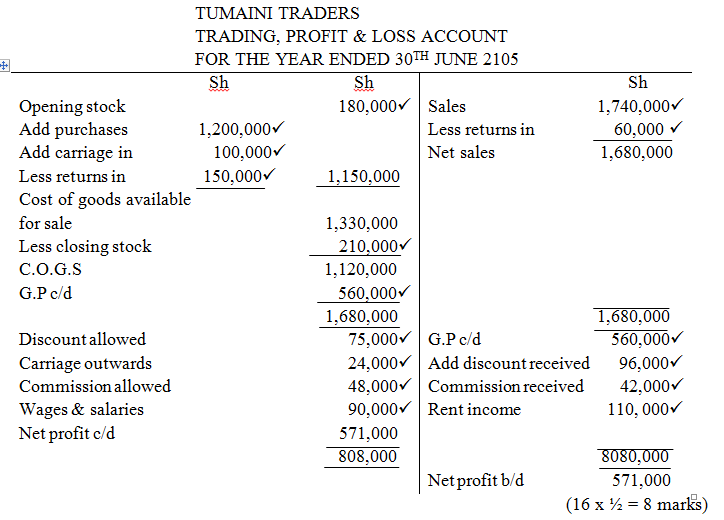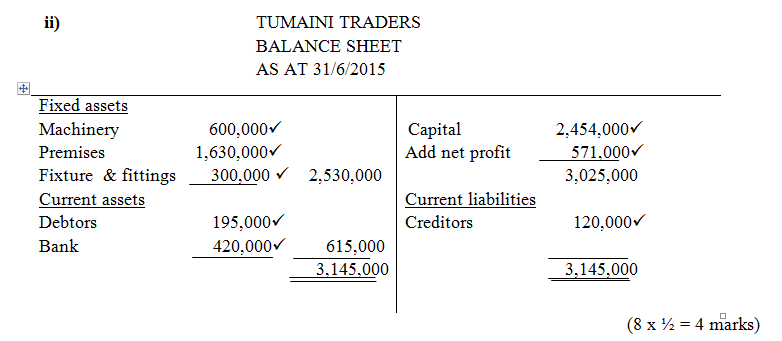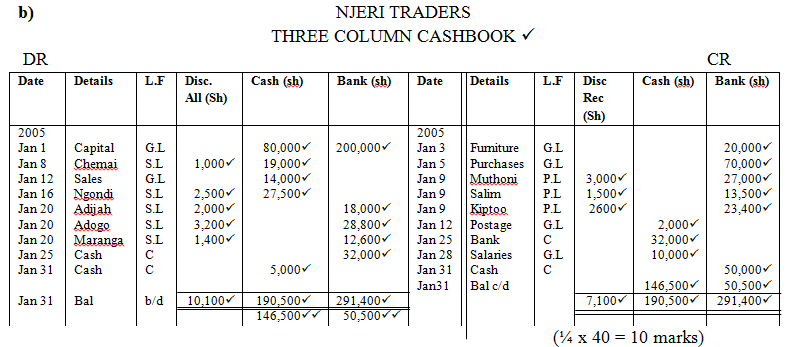Marking Scheme
-
- Causes of unemployment in Kenya today
- Rapid population growth – the work force entering the labour market is more than the economy’s absorption capacit
- Use of inappropriate technology – the use of capital intensive methods of production has limited the growth of job opportunities
- Rural-urban migration – in urban areas there is tremendous pressure on the available resources hence some people and up being unemployed
- Inappropriate education system – sometimes the education acquired in school does not match the realities of the labour market
- Seasonality in production – during peak season employment is high and during off peak seasons employment is low
- Inadequate co-operant factor input – insufficiency of these factors limits the scale of firms operation and subsequent limitation in the expansion of job opportunities (Any 5 x 2 = 10 marks)
- Five roles of transport to the economy of a country
- Bridging the gap between the producers and consumers
- Adding values to good and services
- Widening the market for goods and services
- Providing employment opportunities
- Facilitating movement of factors of production (Any 5 x 2 = 10 marks)
- Causes of unemployment in Kenya today
-
- Five roles of public finance
- Provide essential goods and services – the government is charged with provision of essential goods and services such as public schools
- Control consumption of certain commodities – this is achieved through levying heavy taxes on such products which in turn would raise other prices
- Promote balance regional development – government may start up projects in areas that are lagging behind
- Redistribute wealth – the government redistributes wealth by heavily taxing the rich and using the money to provide goods and services to the poor
- Promote economic stability – public expenditure may be increased in projects that generate employment opportunities
- Raise revenue for the government – public finance raise revenue for the government through taxation
- Create a conducive business environment such as transport for business by use of public finance (Any 5 x 2 = 10 marks)
- Five barriers to effective communication
- Language barrier – communication ineffective where there is lack of shared meaning of language or use of foreign language
- Poor listening – the unwillingness of the recipient of the message to listen bar effective communication
- Negative altitude – lack of trust and respect between the communicating parties will hinder effective communication
- Poor timing – message sends when one is in a hurry may not be properly delivered or received. A telephone call at 2.00 am might not be appreciated
- Use of wrong mediums of communication e.g. one may not convey confidential message over the telephone effectively
- Prejudgement – our earlier experience and knowledge may bar effective communication
- Emotional responses such as those resulting from anger or excitement may lead to distortion of messages
- Unclear system within the organization – If the channels of passing information in an organization are not clear, then the message will not get to the right people for whom it was intended
- Noise any distortion sounds may interfere with the concentration of the recipient
- Use of unfamiliar non-verbal signals which may be misinterpreted due to difference in cultures and age group (Any 5 x 2 = 10 marks)
- Five roles of public finance
-
- Problems likely to be faced by consumer when a firm operates as a monopoly
- Consumers have low quality products as there are no other firms to set up competitio
- Shortage of good and services as there is restriction and control of output / due to hoarding
- High priced goods as the monopoly is a price maker / fixes the price of goods
- Insensitive to consumer complaints as some of the monopolies are government owned
- Limited variety of good thus consumers have no choice (Any 4 x 2 = 8 marks)
-
-
- Problems likely to be faced by consumer when a firm operates as a monopoly
-
- Five ways in which the nature of a commodity may influence its distribution
- Where a product is perishable a short channel is used to avoid its deterioration /fast channel
- Where a product is bulk and heavy a shorter channel is used to avoid increase in cost of distribution
- Where a product is technical in nature a short channel is preferred as it may require demonstration on use
- Where the value of product is high a short channel is used to enhance its security
- Where a product is urgent (emergency goods) a short channel is used so as to meet demand in time (Any 5 x 2 = 10 marks)
- Difference between a public limited company and partnership
(Any 5 x 2 = 10 marks)Public limited company Partnership Minimum number of seven members Minimum number of to members No maximum number of members Maximum number of 20 memebers and so for professional partnerships Has limited liability Some partners have unlimited liability Management is by elected board of directors Managed by partners Enjoys a perpertual life Has limited life Separate legal entity Partnership and partners seen as one
- Five ways in which the nature of a commodity may influence its distribution
-
- Reasons for continued existence of small firms
- Quick decision making – In situations where they may opt to maintain a small business
- Flexibility of small firms – small firms are more adaptable to changing circumstances
- Simplicity of organization – they avoid bureaucracy, wastage and managerial complexity associated with large scale organizations
- Need to retain control – in order to retain control and independence, the owner of the firm may wish to keep it small
- Legal constrains – the law may restrict the growth of a firm, for example the government may impose tax on products of production exceed a certain set limit
- Rising cost of production – where production costs rise so fast such that diseconomies of scale set in very early the firm has to remain small
- Size of the market – if the market for the product produced by the firm is small, a firm may choose to remain small (Any 5 x 2 = 10 marks)
- Benefits enjoyed by a firm that has expanded its operations
- Marketing economies – Large trade discounts, cheaper advertising and distribution costs
- Capital financial economies – access to loans at low interest rates, cheaper administrative costs and bigger capital for further expansion
- Risk bearing economies – reduced risks due to market failure because of diversified market and product
- Managerial economies – firms are able to employ qualified staff that helps in increasing firms output
- Technical economies – large firms are able to employ machinery and labour more economically
- Welfare economies – availability of incentives to workers such as recreational facilities, health, housing and education that keeps motivating the workforce
- Research economies – firms are able to finance research on new methods of production hence reaming competitive in the market (Any 5 x 2 = 10 marks)
- Reasons for continued existence of small firms
-
- Five instruments of monetary policy a central bank may use to reduce money supply in the economy
- Increase in bank rate – if the central bank wants to money supply in the economy it raises its lending interests rate to commercial banks. Commercial banks in turn will lend money to individuals and business organization at high interest rate. This reduces the borrowing from commercial bank by individual and business organization
- Open market operation (O.M.O) – the government may sell securities like treasury bills and bonds to the public, people buy these securities by giving cheques from central bank drawn on commercial banks. This reduces the volume of money commercial banks would have lend out
- Liquidity ratio – also called the cash ratio. It is the amount the central bank requires the commercial banks to hold inform of cash in order to meet the needs of customers who may need to withdraw money. If the central bank raises the liquidity ratio then the money supply in the economy reduces
- Compulsory deposits requirement – the central bank require commercial bank to keep a certain amount of deposits with it. To reduce money supply the central bank raises the compulsory deposit requirement. This leaves commercial banks with little money to lend
- Selective credit control – this is where the central bank instructs commercial banks to give credit to some sectors of the economy and not others.
- Directives and requests – the central bank may instruct commercial banks and other money lending institutions to charge high interest rates so as to reduce money supply (Any 5 x 2 = 10 marks)
-
- Five instruments of monetary policy a central bank may use to reduce money supply in the economy
Join our whatsapp group for latest updates
Tap Here to Download for 50/-
Get on WhatsApp for 50/-
Download BUSINESS STUDIES PAPER 2 Marking Scheme - 2017 KITUI MOCK EXAMINATION.
Tap Here to Download for 50/-
Get on WhatsApp for 50/-
Why download?
- ✔ To read offline at any time.
- ✔ To Print at your convenience
- ✔ Share Easily with Friends / Students




